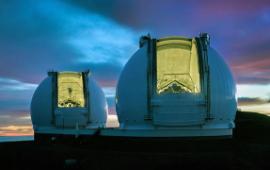Swinburne extends key astronomy research partnership with Caltech

In Summary
- Astronomy research partnership with Caltech extended to 2023
- Access to W M Keck Observatory for up to 10 nights a year
- Collaborative projects on gravitational waves, data science and more
Pioneering research into supernovae, galaxy formation, Fast Radio Bursts and gravitational waves has been boosted with the renewal of Swinburne University of Technology’s research partnership with the California Institute for Technology (Caltech) for a further five years.
The new agreement covers access to the world’s largest ground-based optical telescopes, located at the in Hawaii for up to 10 nights a year until 2023.
It also includes collaborative research on a wide range of strategic projects, including development of advanced visualisation and machine-learning techniques, data driven discovery and joint training programs for data scientists combining teaching resources at each institution.
“Swinburne’s Centre for Astrophysics and Supercomputing is the largest astronomical research group in Victoria and has been privileged to have this exclusive collaboration with Caltech – owned by the California Association for Research in Astronomy – since 2008,” Swinburne Deputy Vice-Chancellor, Research and Development, Professor Aleksandar Subic, says.
“No other astronomy group outside the US has similar access to telescopes of this scope supported by the collaborative research effort of our leading researchers.”
The Keck Observatory atop Mauna Kea, has two ten metre wide telescopes. Through their unrivalled observations of stars, planets and galaxies seen billions of years back in time, they have provided some of the most spectacular views of the Universe ever obtained.
More than 9000 kilometres from the observatory, Swinburne’s Hawthorn campus houses a control room that allows Swinburne astronomers to control the Keck telescopes with a direct video link to the top of Mauna Kea.
“This is the furthest distance a telescope of this class has been remotely controlled in real time,” says Professor Karl Glazebrook, Director of the Centre for Astrophysics and Supercomputing at Swinburne.
“Having this remote access saves travel time and money for researchers and allows staff and students to work closely while on opposite sides of the world.
“With a generous donation recently received from a trust managed by former Swinburne staff member, Graeme Baker, we are now upgrading this to an even bigger facility that can accommodate larger research teams,” Professor Glazebrook says.
Using the observatory’s cutting-edge instrumentation, astronomers have produced amazing discoveries about the Universe.
Over the past five years, direct access to the Keck Observatory has enabled Swinburne astronomers to make landmark discoveries such as:

